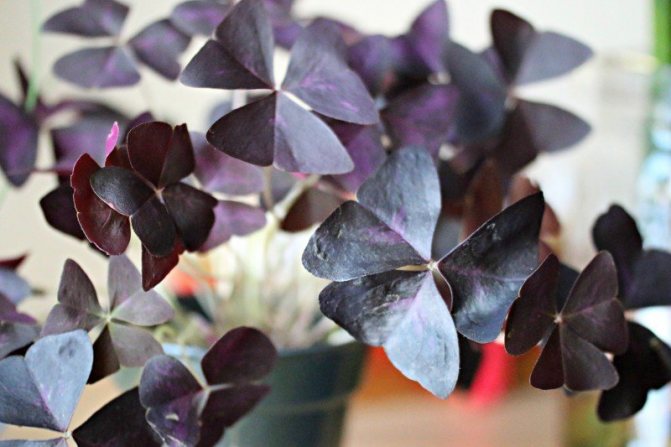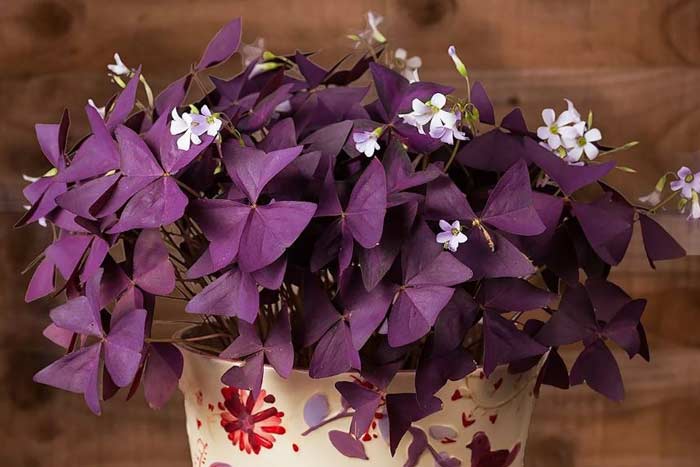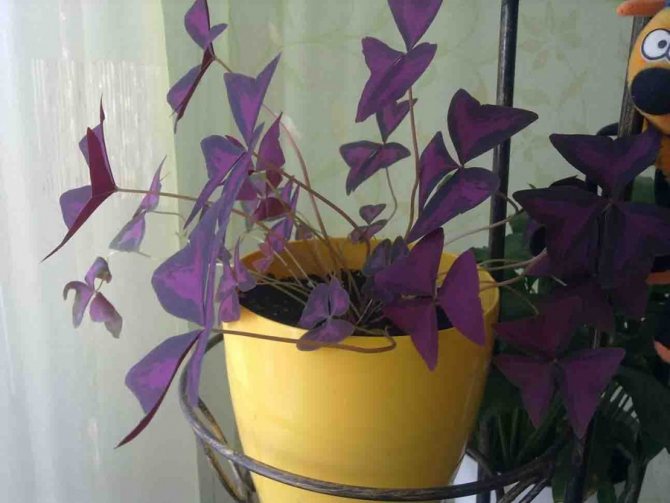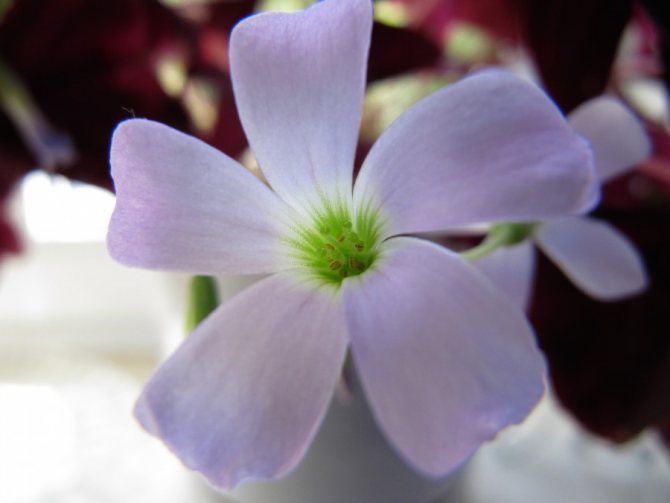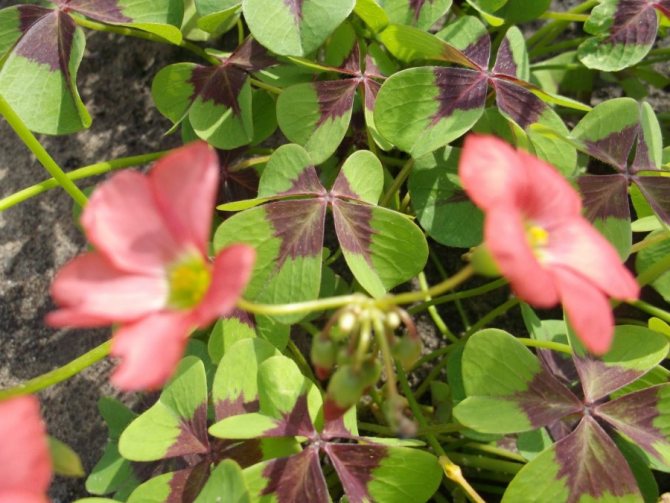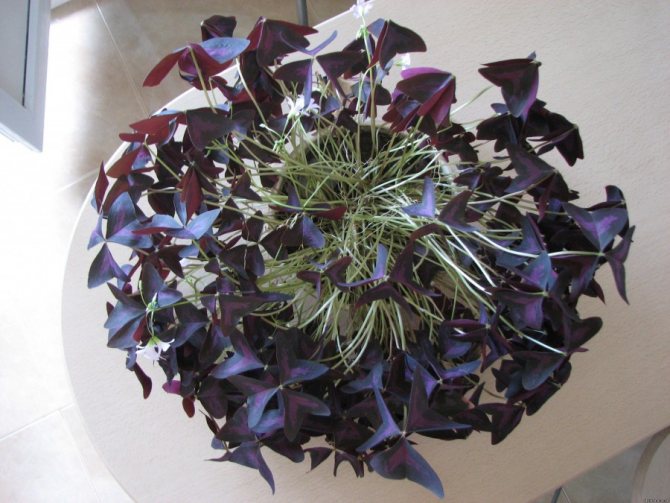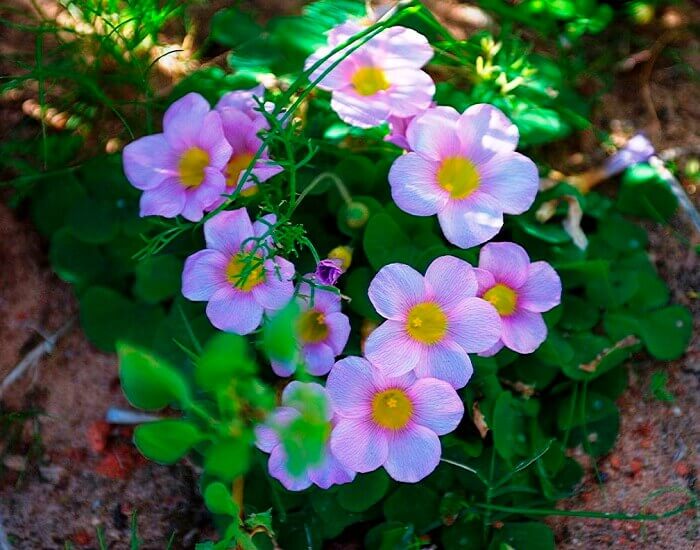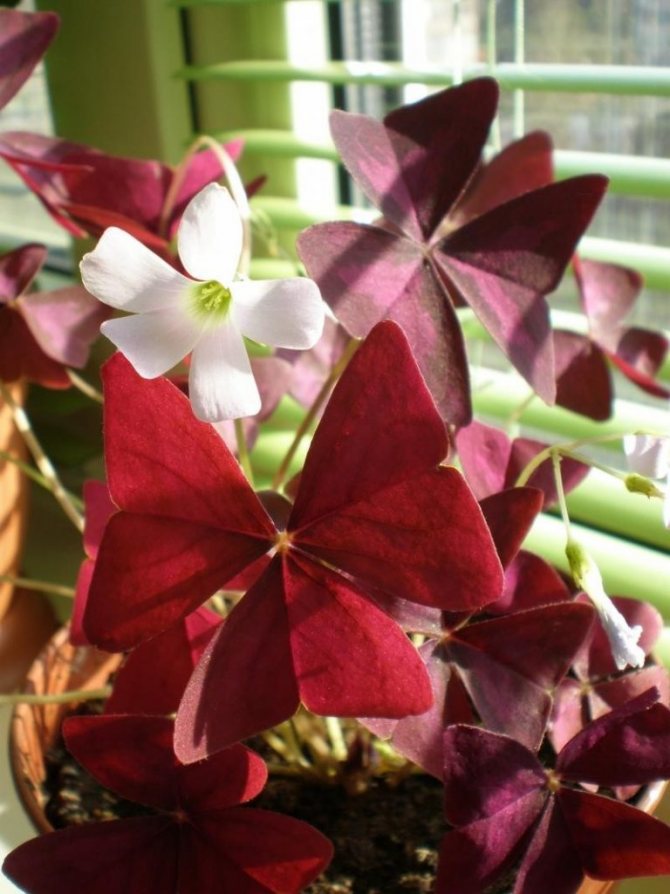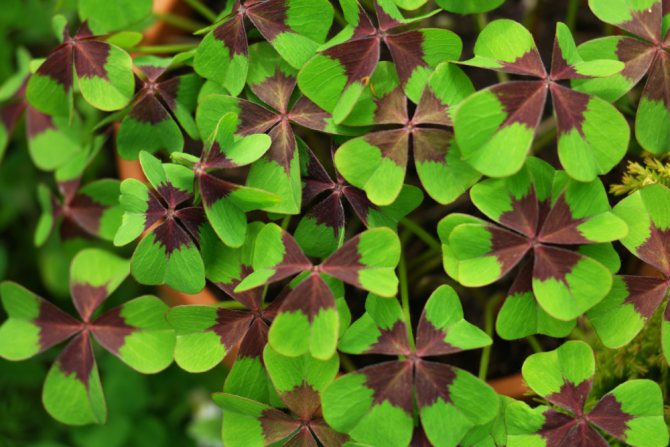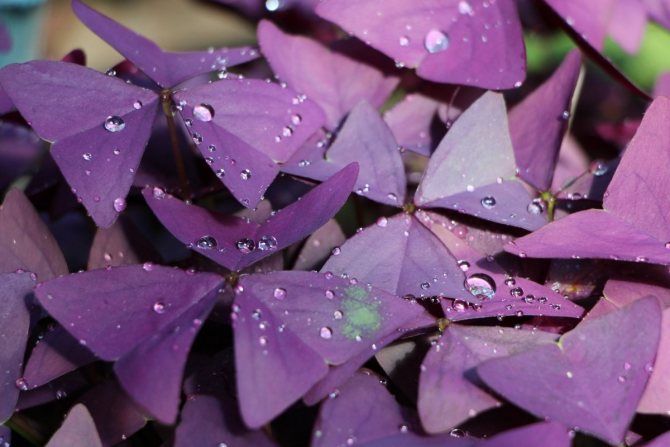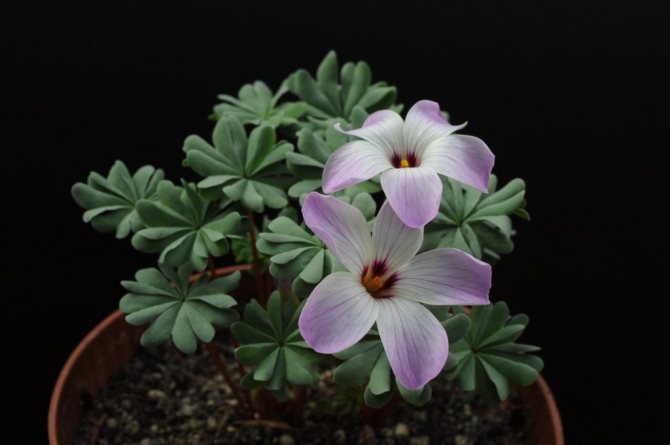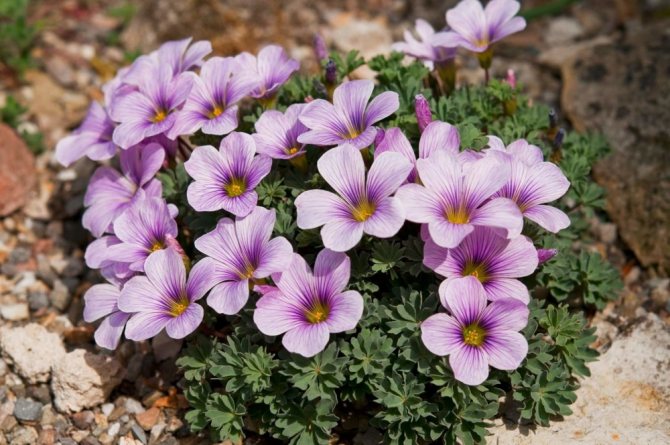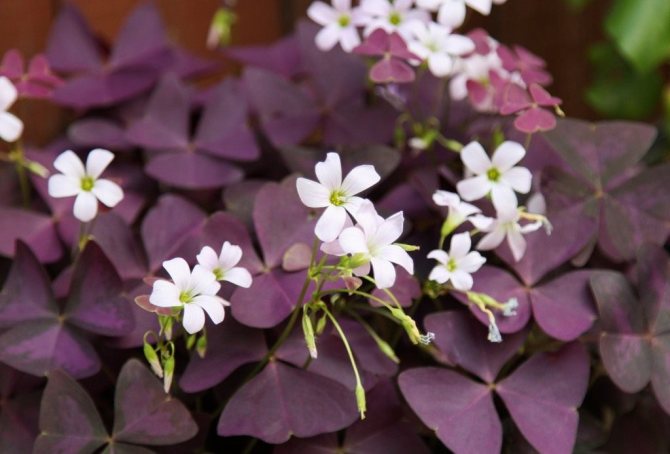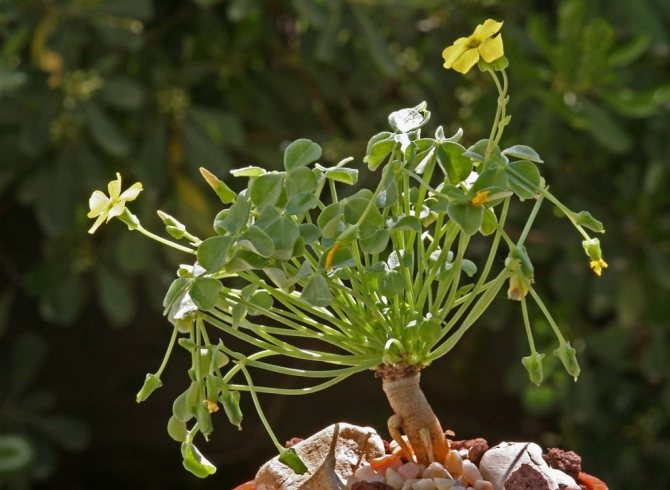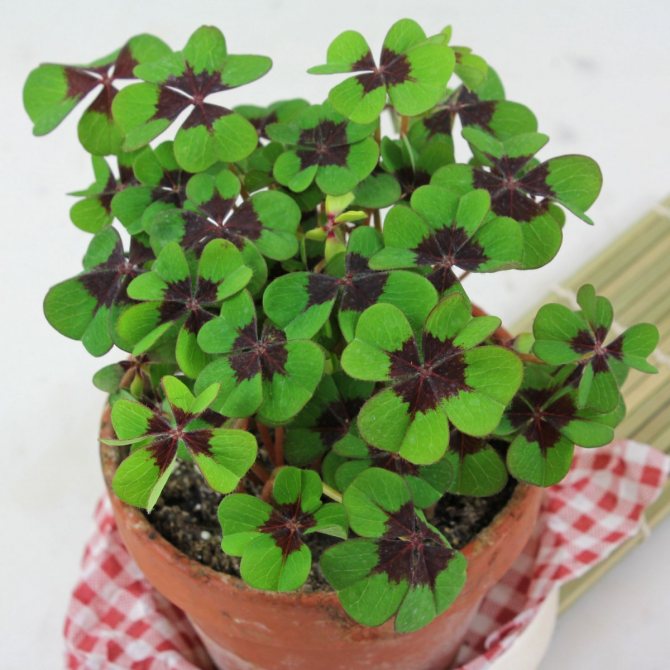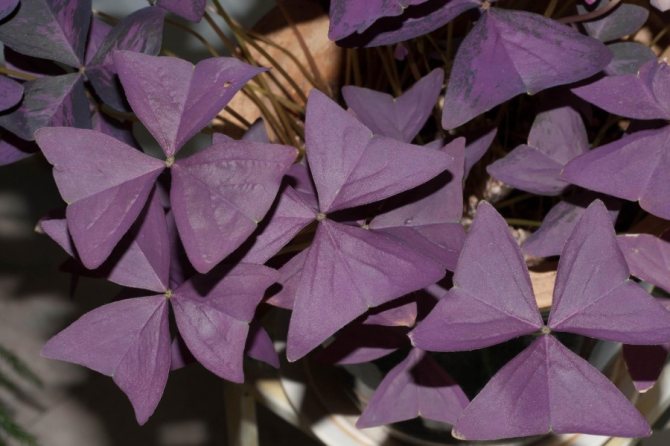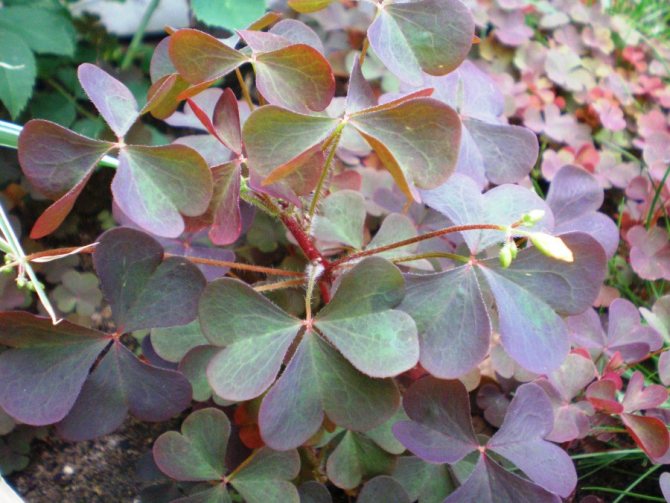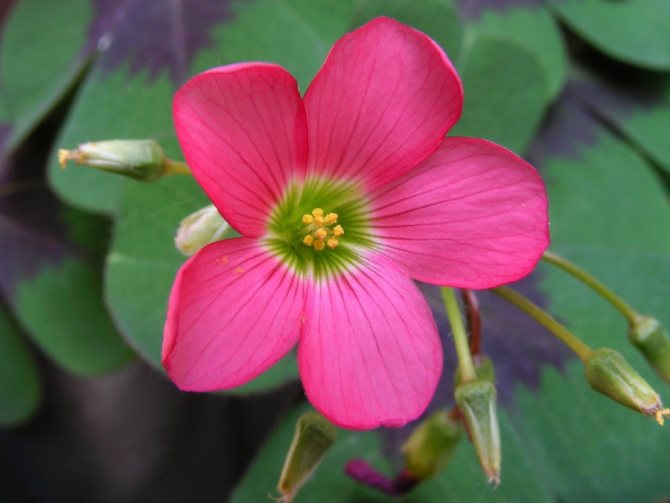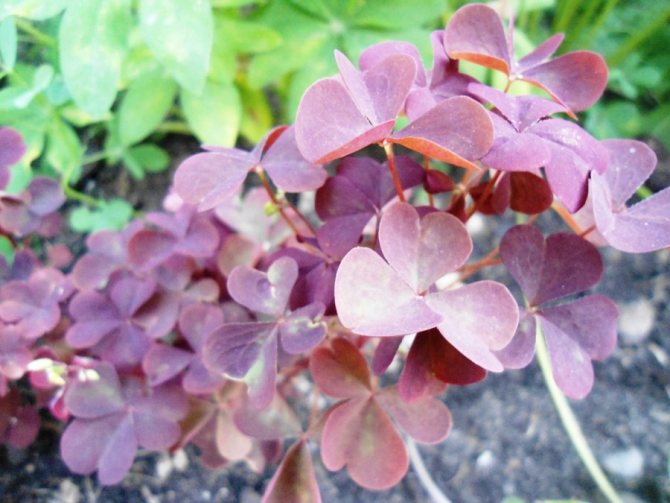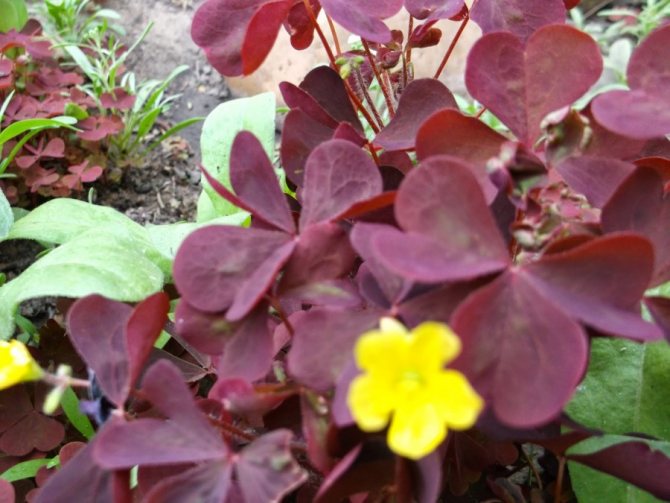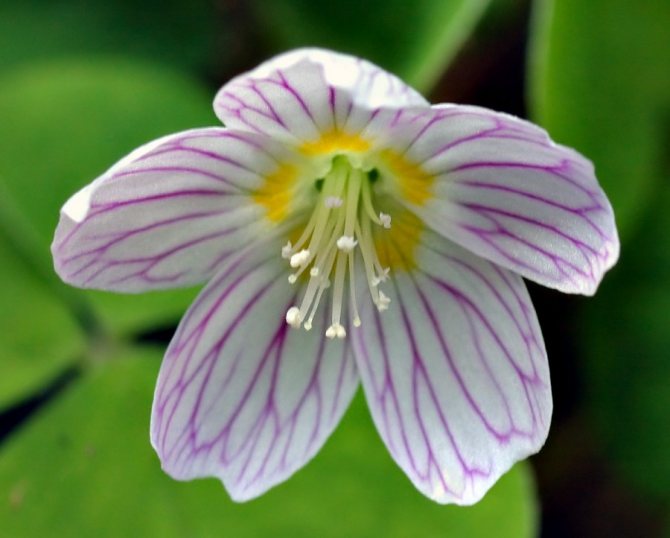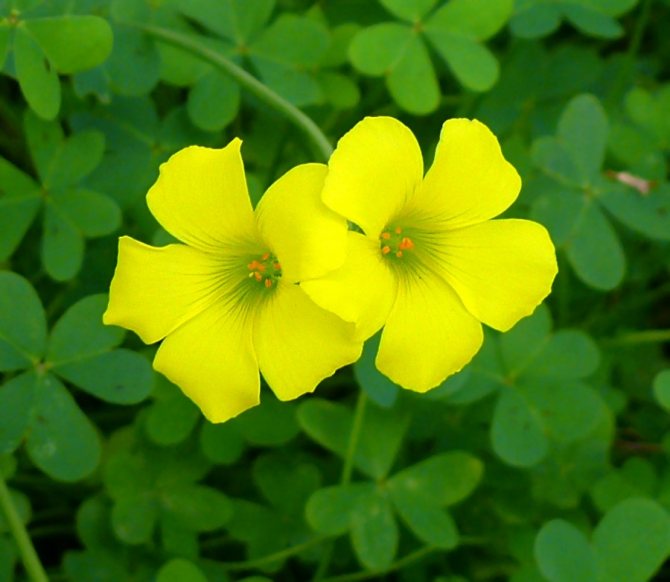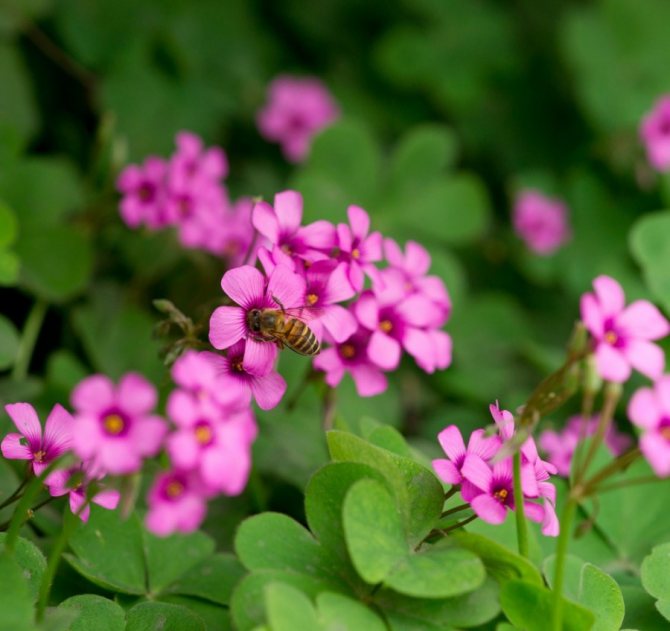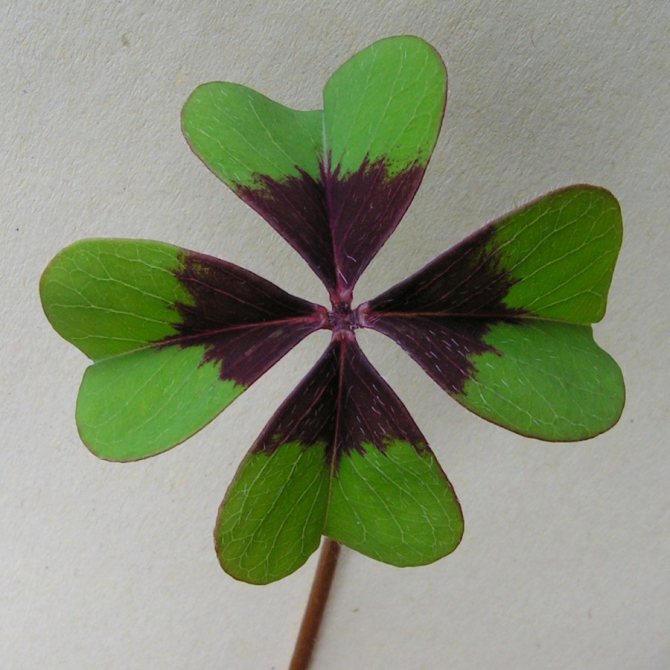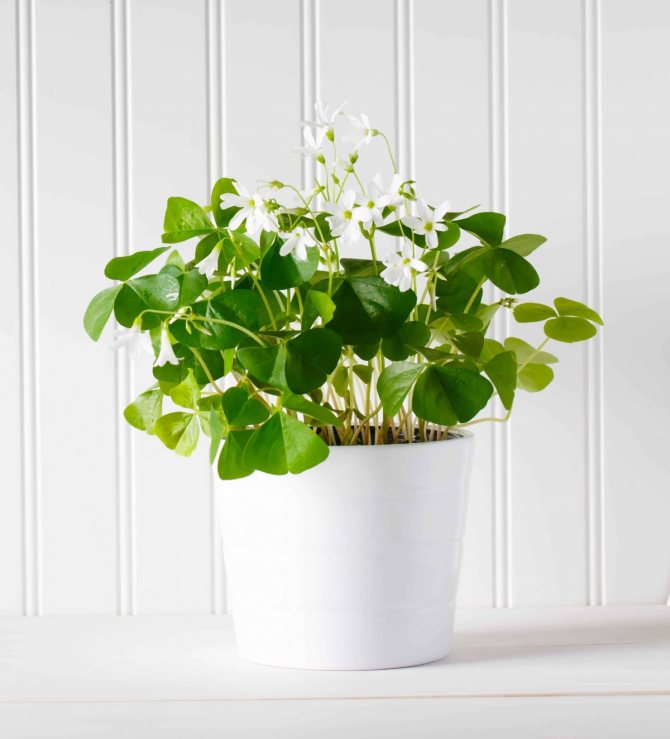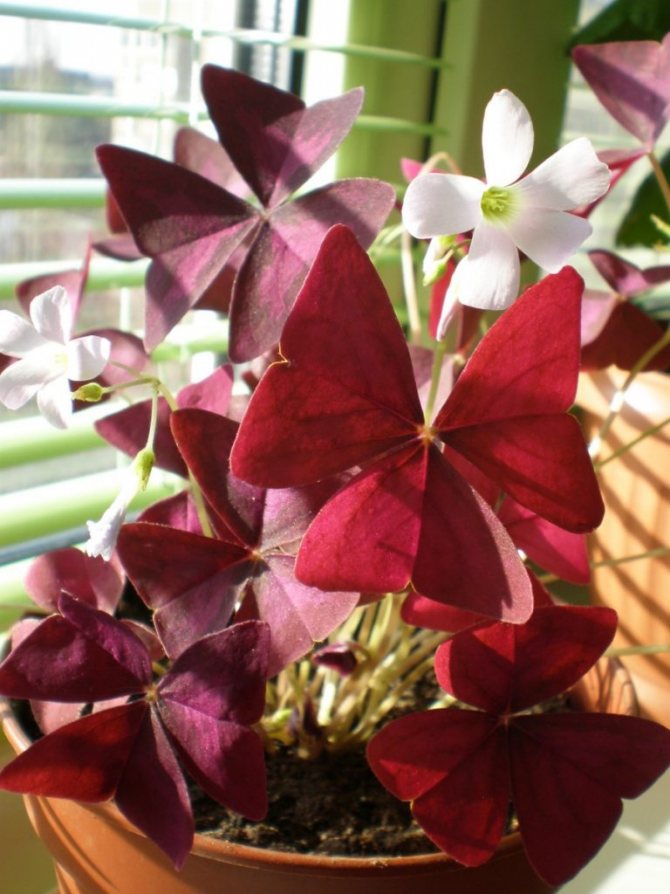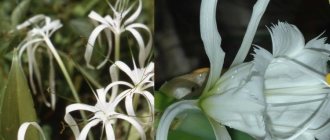Kislitsa or oxalis (scientific name), also known as false clover, and in the common people called hare cabbage. And, probably, many are familiar with this plant and have even tasted it. The main thing is that it brings many benefits to the human body, and not just a beautiful plant in the forest, in a flower bed or at home on a windowsill.
Why is oxalis called false clover? Because they have similarities and some confuse these two plants. But, the clover has a dark green rim along the edge of the leaves, while the sour cherry does not, and the flowers are not alike at all. Oxalis ordinary has a lot of varieties that amaze with the beauty of flowers, color and shape of the leaves. You will learn about them in detail from this article. And not only about that. Also in the article you will read how to propagate a plant, how to care for it at home and about the medicinal properties of this herb.
Bloom
Under natural conditions, the herbaceous plant produces flower stalks from May to July. Flowers have an interesting ability - they open in the morning and close at night. Some oxalis varieties can bloom almost all year round with proper care..
Interesting! Some buds open fully in clear weather, remaining half-closed in cloudy weather.
A separate corolla blooms for only a few days, so the plant replaces the wilted with new ones. With this feature, flowering can continue non-stop for several months.
Useful properties of acid sour
In traditional medicine, parts are more often used Carob oxides, or horned oxalis (Oxalis corniculata) - flowers, peduncles, leaves. The plant contains organic acids (oxalic, malic, citric). Raw materials are harvested in spring or early summer (May – June) and dried at a temperature of 40-50 ° C.
The plant improves metabolism, enhances appetite, has an antihelminthic, hemostatic, wound healing, urinary and choleretic effect. Oxalis is a good antiseptic. In addition, oxalis eliminates heartburn, vomiting, normalizes the acidity of gastric juice, and lowers blood pressure.
Infusions, decoctions and tinctures are used for diseases of the liver, kidneys, gall and urinary bladder, gastritis, diathesis, cardiovascular diseases, bleeding, stomatitis, putrefactive processes in the mouth (for rinsing). Sour sour juice is used to treat scabies.
Self-treatment is strictly prohibited!
Signs and superstitions
Since ancient times, it is believed that oxalis is able to charge a home with positive energy, give the owner a craving for life, improve well-being, and cheer up. The house where the perennial grows is able to maintain an atmosphere of lightness, happiness.... The plant is considered ideal for children, as it can protect from the evil eye, bad thoughts, calm sleep.

Kislitsa is an excellent holiday gift for families who believe in the miraculous power of receiving. Such a gift can solve personal problems, improve the well-being of a married couple.
Basic requirements for growing
As with all bulbous crops, oxalis needs time to rest. Do not throw out the bush if the plant is a little withered. With constant and proper care, it will bloom again. The dying off of foliage is a sign that a period of dormancy is approaching.
This crop is often grown in pots. There is a belief that oxalis brings good luck to the house.Therefore, it is so popular among fans of indoor flowers.
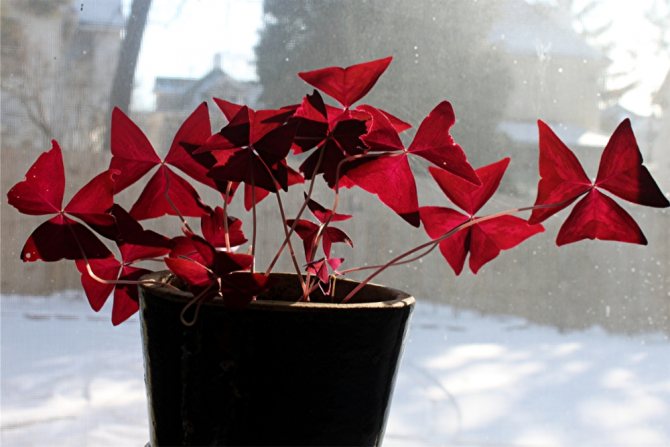

Indoors, oxalis is planted at any time. The bulbs must be refrigerated until planting. To make a design accent, plant should be very close to each other, since rarely planted plants will not make the proper impression. The flower is very unpretentious, but loves a lot of light. In this case, direct sunlight should be avoided.
The houseplant is used for food. But here it is important not to overdo it.
The oxalic acid it contains can potentially cause health problems in the long run.
It is most commonly used as a salad ingredient.
Types of acid with photos and names
There are a large number of plant varieties for home cultivation.
Violet or triangular oxalis (Oxalis triangularis)
An evergreen herbaceous plant known for its unusual coloration. Kislitsa triangular has purple leavesdivided into 3 equal triangular parts. The height of the shoots reaches 30 cm. Flowers are collected in small inflorescences of 3-5 pcs., Snow-white, funnel-shaped, with five petals.


Oxalis tetraphylla (Oxalis tetraphylla)
The homeland of the perennial is hot Mexico. The plant is compact, the shoots rarely exceed 40 cm. Leaves of complex shape, consist of 4 identical heart-shaped segments, green... The flowers are attractive, pale pink, with a greenish core. The variety has a long flowering period: from June to October.


Common oxalis (Oxalisacetosella)
A low-growing herb with shoots only 5-10 cm in length. Leaves are compound, divided into equal segments, green. Petioles are flexible, slightly pubescent along the entire length. The flowers are single, large, white with obvious veins. Perennial foliage is edible, contains a large amount of oxalic acidused for making salads.
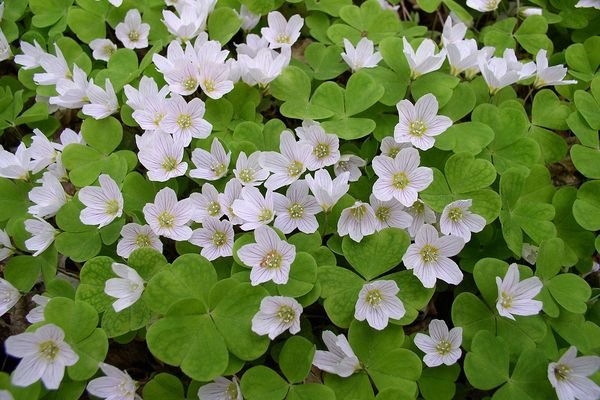

Oxalis Bowiei
A graceful perennial variety, distinguished by large pink corollas, beautiful heart-shaped green leaves. Plant height varies from 20 to 30 cm. Shoots are flexible, covered with fine hairs. In regions with mild climates, it is possible to grow a flower in the garden.
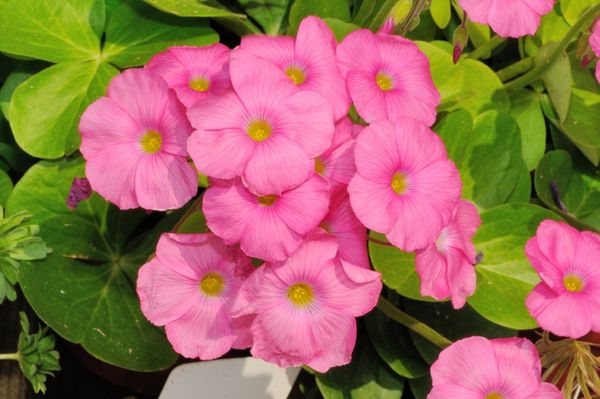

Multi-colored oxalis (Oxalis versicolor)
A well-developed, branched bush with a lot of shoots. Feature of the species - funnel-shaped bicolor buds. The inner part of the petals is colored white, the outer one has a bright pink edging.


Ferruginous oxalis
This variety can be called a ground cover: the height of the shoots rarely exceeds 10 cm.With prolonged growth in one place perennial forms a beautiful "living carpet"... The flowers are purple, large, on short peduncles.
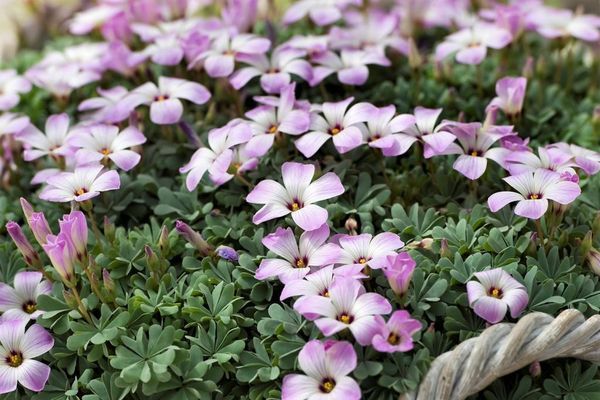

Description of the common sour
Kislitsa is a herbaceous plant of the Kislichny family. Flowering herb from the genus annuals or perennials. This plant weaving on the ground with tuberous roots, which reaches a height of up to 20 cm, is quite hardy, tolerates frost well. Leaflets are trifoliate, cordate. The leaves are painted green, gray-green or burgundy, depending on the type of plant. There are both monochromatic and two-color ones. If you taste it, they are slightly sour, as they have oxalic acid (Figure 1).


Figure 1. Appearance of acid
Interesting: if you touch the leaves, they close, and this process also occurs naturally in the evening.
Expert opinion
Ivan Kuznetsov
Farmer
I would like to advise you homemade oyster mushroom mycelium - the first harvest in 10 days, it grows at any time of the year for free - want to try it?
To learn more
False clover begins to bloom in spring (late May) or summer (early June). A long peduncle has one or more buds. The shape of the flower is in the form of a short tube, which consists of five petals fused together. The petals are rounded with edges bent outward. With the onset of evening, the petals close.
Flowers come in different shades: lilac, yellow, pink and white. They can be pollinated both independently and with the help of insects. Inside the flower there are about nine stamens, long in the form of threads, and one ovary. Pink-lilac streaks are noticeable on the petals.
See also: Meadow foxtail
The seed pods are oblong. The seeds are small, thick-skinned, in the form of a drop, which hide under green valves. The peel contains a lot of sugars that attract goosebumps. These sweet tooth sow sour seeds, spreading them throughout the district. In addition, after ripening, the seeds shoot out, scattering at a distance of one meter.
Home care
Oxalis takes root well indoors. The plant is unpretentious, which makes it popular among beginners in floriculture.
What to do right after purchase?
Having brought home a room acid, you need to give her time to get used to the change of scenery. It is not recommended to immediately water, transplant, feed the plant.
Important! Room acid should be acclimatized within 7-10 days, after which they begin standard perennial care.
Temperature
The optimum for acid sour is + 20 ... 25 ° С. In winter, these indicators can be lowered to +15 ° С. A decrease in the air temperature below negatively affects the health of the plant - the oxalis begins to shed its leaves, the growth of the flower slows down.
Lighting, comfortable place
The herb is photophilous, however does not tolerate direct sunlight... Ideal content on western or eastern windowsills.
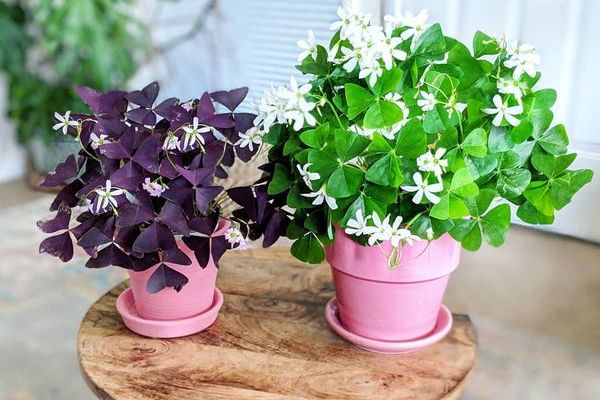

Pruning
To maintain a decorative appearance, remove dried leaves and flower stalks. It is important to do this during the dormant period of acid.
Attention! Pruning can stimulate the active growth of the pot culture: for this, you need to slightly shorten the shoots.
Shade tolerance
Homemade acid normally tolerates shaded areas. However, the grower should prepare for slow growth, inactive flowering, if the culture is in the shade for a long time. Leaves of purple varieties can fade from lack of light., therefore, it is recommended to organize additional illumination with lamps in winter.
Resting care
In the cold season, the flower hibernates, restores strength.In winter, it is recommended to move the acid plant to a cool place, reduce the frequency of watering, and stop spraying the foliage.
View this post on Instagram
Posted by @ fikus_74 Aug 25, 2019 9:46 am PDT
When and how to transplant?
Young oxalis actively builds up the root system, therefore transplant is required annually... It is recommended to carry out manipulations in the period from April to May, when the plant finally "woke up" after a period of dormancy. An adult flower requires a transplant only in a few cases:
- shoots have grown too much;
- plant disease.
The transplant is carried out by the method of transshipment of an earthen coma:
- Carefully remove the acid lily from the old pot.
- Pour a drainage layer (expanded clay, perlite, polystyrene) on the bottom of the new container.
- Move the acid sour into a new pot.
- Fill the voids with soil.
Water the flower abundantly at the end of the transplant.
What kind of soil to use?
The easiest option is to buy a ready-made universal soil for indoor plants in a specialized store. You can prepare the soil mixture yourself: mix turf, humus, leafy soil, peat, river sand in equal amounts.
The universal primer is completely ready for use.Self-made soil must be treated from parasites by calcining or short-term freezing, processing with a weak solution of potassium permanganate is allowed.
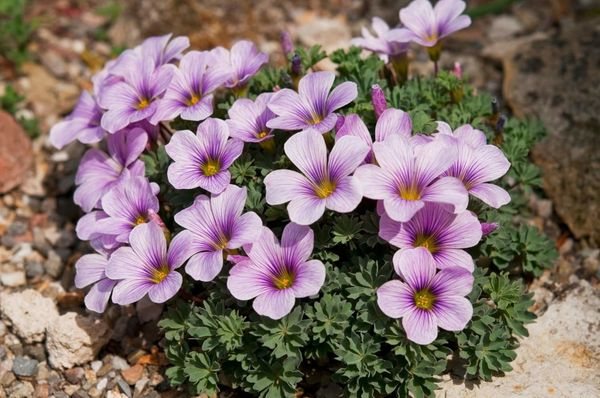

What kind of pot is needed for a plant?
For growing sour cherry at home ceramic flowerpots with a hole in the bottom are recommended to drain excess moisture, plastic containers are also acceptable. The pot should be shallow, but wide, since the root system of a perennial is nodules growing in breadth.
Each subsequent container during transplantation should be 2-3 cm larger than the previous one. You cannot use too large flowerpots.: in this case, the plant will spend all its energy not on flowering, but on building up the root mass.
How to Provide Proper Oxalis Care
If there is not enough light for the flower, it will stop blooming, the leaves will turn pale and fall. Therefore, the north window is not suitable for the plant. If you take good care of the acid at home, it will look like in the photo.
Kislitsa is demanding to comply with the water regime. The earth should not dry out, but delicate plants cannot stand moisture stagnation either.
Winter watering should be sparse, just not to dry out. Leaves love when droplets of soft settled water collect on them. You need to fertilize the delicate plant little by little, using half the recommended dose.
Reproduction
Several methods are used to increase the acid sour population. The most popular are described below.
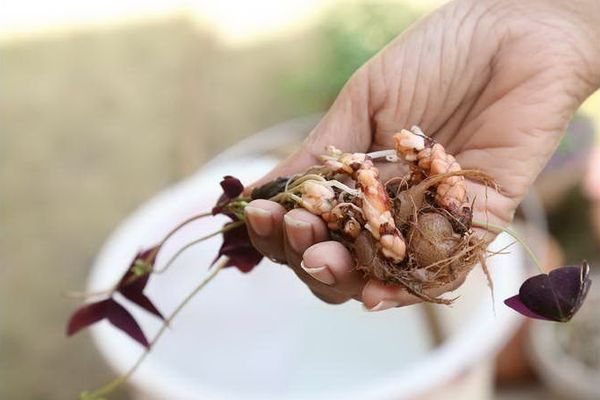

Tubers
Seed planting material in March. Tubers cut off from the mother bush are placed in a common container, lightly sprinkled with soil. Until the roots appear, a constant temperature should be maintained at + 10 ° C, periodically moisten the ground. The first roots will appear after 15-20 days... One month after planting, the temperature should be raised to + 20 ... 25 ° C.
Advice! Tubers ready for planting in a permanent place should be washed in a weak solution of potassium permanganate for disinfection.
By dividing the roots
During a planned transplantation of acid, you need to carefully, using a sharp knife, divide the mother bush into several parts. Each new plant must be transplanted into an individual cup.
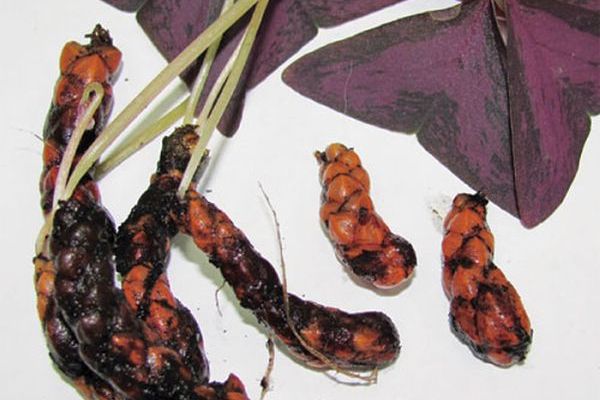

Seeds
You can sow seeds both in separate and in common pots. It is important not to deepen the planting material too much, otherwise the seedlings will have to wait a long time. The containers must be covered with plastic wrap to maintain the internal microclimate until sprouts appear, the humidity must be at a constant level. Viable seeds sprout 10-14 days after sowing.
Attention! You can transplant young acid lilies into pots when 4 real leaves appear.
By cuttings
Using a sharp knife, separate the stalk from the mother bush, plant it in a container with wet sand. After 20 days, the cutting will give roots and will be ready to be transplanted to a permanent location.
Where does oxalis grow
Oxalis grows in coniferous and deciduous forests, near water bodies, and it can also be found in garden plots. Loves shady and humid places, acidic soil. Varieties of this plant grow in Europe, Asia, as well as in Ukraine, Russia, the USA and the southern part of the African continent (Figure 2).
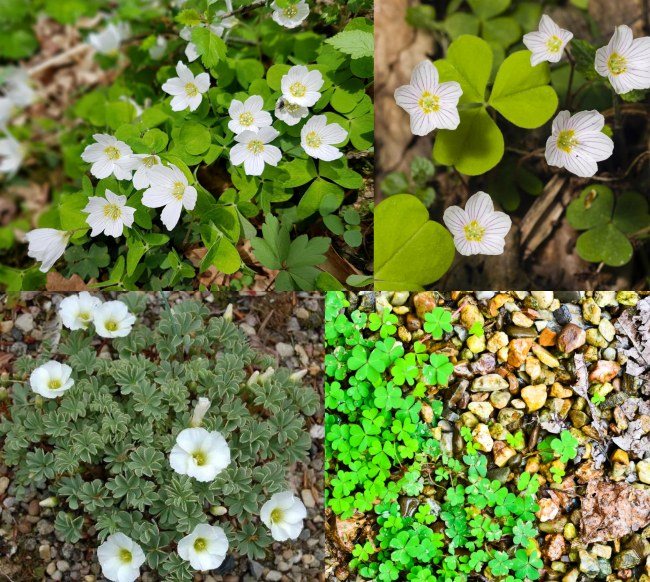

Figure 2. The plant is found in the forests of many continents
Hare cabbage is considered an ornamental plant, so it can often be seen in flower beds, alpine slides, as well as planted in pots on windowsills, both in private and in apartment buildings.
Possible growing problems
A novice florist may face some problems when cultivating even such an unpretentious plant as oxalis.
View this post on Instagram
Posted by Svetlana Romanyuk (@ 29061983cveta) Oct 11, 2019 at 4:58 PDT
Why doesn't it bloom?
Often the reason for the lack of flowering is disturbed dormant period of acid... In this case, the flower is depleted, the perennial does not have the strength to form peduncles. Another possible reason is excess of minerals.
Diseases
The herbaceous flower is considered a crop resistant to a variety of diseases. However, improper care can lead to some problems:
- Decay of the root system... It is characterized by wilting of shoots, they become translucent, fragile. The reason is excessive watering. You can save the acid by transplanting it into a new container with dry soil.
- Sunburn occur when direct rays hit the foliage of a flower. In this case, the acid must be removed to a shaded place, and the affected shoots must be removed.
When the air is too dry, the foliage begins to dry out, curl. You can solve the problem by using a household humidifier.
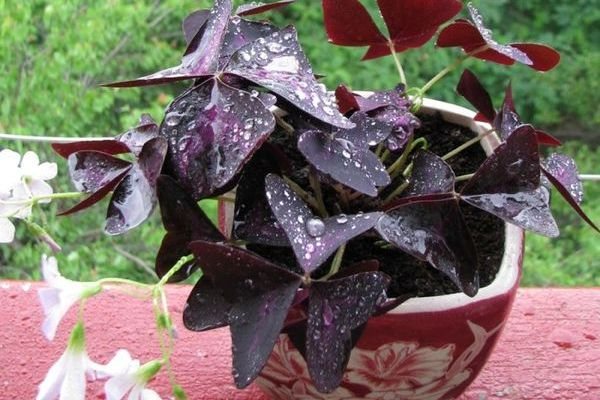

Pests, diseases and control of them
The houseplant oxalis is not often, but it is susceptible to disease. Any method is suitable for pest control: mechanical, chemical or folk method.
The plant is often attacked by:
- shield;
- whitefly;
Gardeners apply insecticides and spray the flower under running water. You can take laundry soap, alcohol and wipe the leaves on top.
In addition to pests, there is also a danger of decay of the root of this plant, so it should be watered in moderation.
What do we know about him? Here are some interesting facts:
- his homeland is South Africa, Mexico and South America;
- there are about 800 flower varieties in the world;
- the unofficial symbol of Ireland is the three-leaved oxalis, not the clover;
- Catholics often give these purple butterflies for Christmas;
- in the dark, the plant folds its butterfly leaves.
Medicinal properties of acid
Oxalis is also a medicinal plant, but sour acid is used for medicinal purposes.
Application:
- treatment of scurvy of teeth;
- washing wounds;
- antidote to arsenic and mercury;
- antihelminthic, diuretic;
- strengthening immunity and fighting colds.
Pests
The following insects are most dangerous for a flower.
Aphid
Green bugs, the places of accumulation of which are veins on the foliage, from where they suck the sap of the plant. Insect damage leads to drying, death of leaves... It is possible to fight aphids by using insecticides "Aktara", "Inta-Vir", spraying perennials with a strong solution of household soap 72%.
Shield
Insects are relatively large in size, visible on foliage with the naked eye. Like aphids, they feed on plant sap. It is possible to save the acid sour with the timely processing of "Aktara". The positive effect is also noticeable after mechanical processing of the leaves with a soft brush dipped in soapy water.
Whitefly
Small insects with wings actively move to nearby plants. For the fight, it is recommended to treat with preparations "Aktara", "Fitoverm".
Spray also flowers adjacent to sour.
Basic information about the plant
Oxalis ordinary - a resident of deciduous forests in central Europe and Russia. This is a perennial plant that reproduces in the spruce forest by creeping rhizomes. Leaves resembling butterfly wings are located not high above the ground. Air tassels of flowers soar above them. Ripe seeds are shot out of the capsule, giving life to new plants.
The plant is named acidic for its sour taste, they contain vitamin C and oxalic acid. Vitamin spring greens.
The leaves are trifoliate, there are types with four lobes, forming a circle when folded. They have a different color due to the presence of carotenoids in the composition. A modest grows in the forests Oxalis acetosella
, room oxalis is much more decorative. In home breeding, the most common variety has become violet oxalis. Many amateurs breed varieties of a different color and structure of the leaf blade.
Chlorophytum: benefits and harms
It has been scientifically proven that an unsightly, at first glance, plant has a whole range of useful properties:


- bactericidal effect (destroys harmful microorganisms nearby due to the released phytoncides);
- functions as a "biofilter", cleans the air from toxic substances;
- absorbs carbon monoxide, formaldehyde, ammonia, benzene, nitrogen, acetone;
- powerful air humidifier (gives out almost all the moisture consumed).
Oxalis in the garden
Oxalis grows equally well in partial shade and on an open, sunny lawn. The soil should be nutritious, loose and breathable. The acidity of the soil is recommended to be neutral or slightly acidic. If necessary, before planting, the earth is dug up with the addition of compost and peat. Young plants are planted at a distance of 10-12 cm to a depth of 3-4 cm. Planting is best done in the second half of spring in warm, cloudy weather.
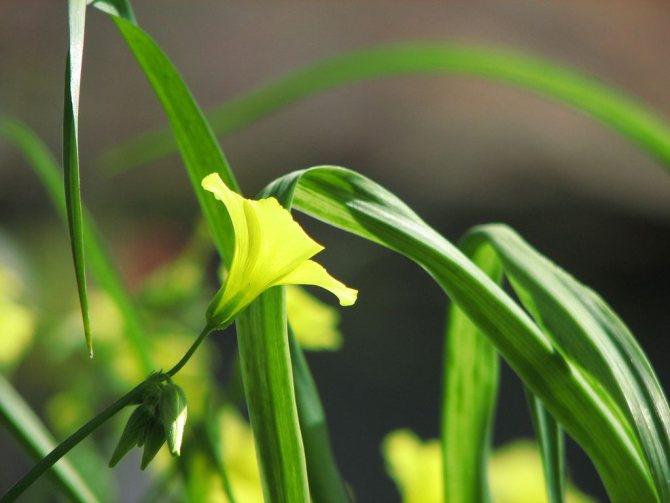

Plants usually have enough natural rainfall. If the drought is prolonged, the bushes are watered in the morning or closer to sunset with a small amount of water.
Infrequently, every 1-2 months, the sour cherry is fed with a highly diluted mineral complex or "Mullein".
In autumn, a heat-loving plant must be prepared for wintering. To do this, you should well mulch the soil at the roots. You should not be afraid for the condition of the ground part, it will dry out in any case, and a thick layer of mulch will help the tubers and roots to survive until next spring.
Ferruginous oxalis (Oxalis adenophylla)
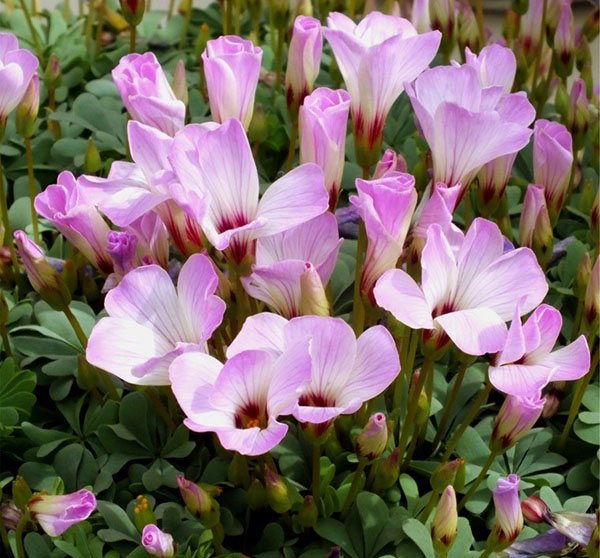

Winter-hardy ferruginous oxalis is often grown in gardens as an unpretentious ground cover plant with a height of only 10 cm. Florists are attracted not only by the undemanding culture, but also by its decorative qualities - silvery feathery foliage and pink-lilac flowers with raspberry veins and a spot at the base of each petal.
Use in cooking
Oxalis leaves are used to prepare interesting and healthy dishes. They are used to add spicy sourness to soups and green cabbage soup, add to egg dishes and salads. Refreshing vitamin drinks and sour teas are useful for those who follow the figure, they quench their thirst and reduce appetite. The herb will give cheese pancakes and cottage cheese pancakes an original taste and will become a delicate filling for pies. In a pureed form, oxalis will serve as a side dish or a paste for dressing salads. Dry leaves are used as a condiment for sauces and soups.
Salted sour liquor is harvested for the winter. To do this, the plant is mixed with herbs, chopped horseradish root and black currant leaves, peppercorns and garlic cloves are added and poured with brine.
Fresh, harvested during the flowering period, the herb will retain its beneficial properties for a long time in a candied form. However, when eating, moderation is important: an overdose of acidic acid causes serious harm to health.
Kislitsa room: folk signs
Oxalis or oxalis is popular as a room and garden crop, due not only to the external beauty and ease of growing, but also to positive signs:
- The flower is called "good morning" because at dawn its leaves unfold, at sunset they curl up. But in bad weather, the leaves remain folded. That is, the plant predicts weather conditions: looking at it in the morning, you can understand whether to take an umbrella with you or not.
- Kislitsa as a symbol of good luck and a prosperous future is presented in many countries to birthday people and new settlers.
- People who have received a shamrock as a gift for Christmas or New Year will be lucky and happy.
- In some countries, it is considered good form to give a plant to a lonely person. The giver, as it were, wants the recipient to find a soul mate as soon as possible, to find family happiness.
- There is a belief that people who exchange "butterflies" give each other good luck and prosperity.Therefore, connoisseurs will advise neighbors to exchange flower pots.
- If the oxalis suddenly dried up, then it took the misfortune or illness from the owners.
- If you don’t like the presented “clover of happiness”, you should donate it to another person. A plant you don't like cannot be kept in the house, it will absorb only negative energy from the owner, then spray it around the house.
IMPORTANT! It is good if there is an opportunity to grow acid in the children's room. The child's creative abilities will be revealed faster and brighter, the immune system will be strengthened.
All home and garden types of acid lily have a positive energy, bring positiveness to the home, improve family and love relationships. But signs come true only with proper care of the shamrock. In gratitude for the care and attention, the "butterfly" presents the owners with happiness and success.
1 / 5 ( 1 vote)
Brief description of cultivation
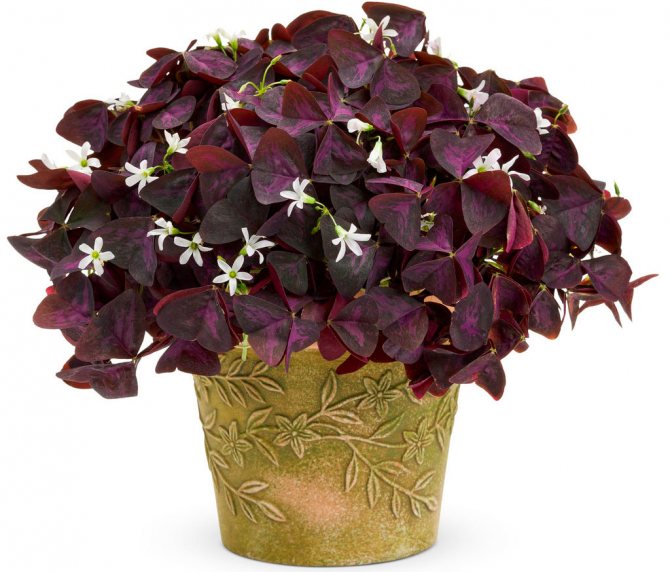

- Bloom... From the last days of May or from the first - June until the very winter.
- Illumination... A bright light is needed, which must be necessarily diffused.
- Temperature regime... During the growing season, the air temperature should be in the range from 20 to 25 degrees, and during the dormant period - from 12 to 18 degrees.
- Watering... In the spring and summer, watering should be abundant, and in the cold season - from moderate to scarce.
- Air humidity... It grows well with air humidity, which is typical for living quarters, but if the room is too hot, then sometimes moisten the foliage with a spray bottle.
- Fertilizer... During intensive growth, fertilizing is carried out 1 time in 15–20 days, for this, mineral complex fertilizers are used in half the dosage recommended by the manufacturer.
- Dormant period... It starts after flowering and lasts 4-6 weeks.
- Transfer... Young bushes are transplanted every year, and adults - once every 2 or 3 years.
- Reproduction... Most often, nodules or daughter bulbs are used, and more rarely, the seed method.
- Harmful insects... Aphids, scale insects and spider mites.
- Diseases... Fusarium and gray rot.
- Properties... This plant has medicinal properties, its foliage contains a large amount of vitamin C.
Humidity and watering
Oxalis does not have any special moisture requirements. Spraying the leaves is allowed only in the warm season. Moreover, the water must be settled or boiled.
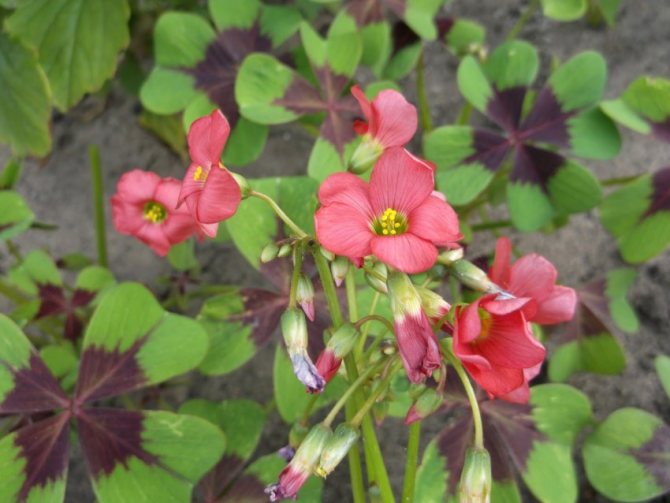

The plant loves abundant watering. But it is necessary to ensure that the water in the soil does not stagnate - this can lead to decay. By winter, the amount of watering is reduced.
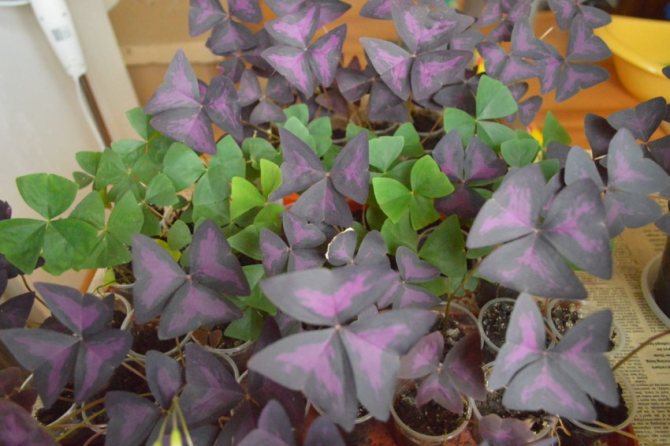

Collection and storage of dosage forms
For the procurement of medicinal raw materials, leaves, inflorescences and the herbaceous part of the plant are used. The optimal time for harvesting is the flowering period from late April to early June, when the concentration of biologically active substances reaches a maximum. Fresh and dry herbs are suitable for the preparation of medicinal compositions. The acid is cut and laid out under a canopy with good ventilation or placed in special dryers. The finished mixture is poured into cardboard boxes or paper bags and retains its useful qualities throughout the year.
Who can give a flower
The oxalis flower is a good gift because of the superstition and acceptance associated with it. Esotericists claim that if you give a purple sour cherry for the New Year, happiness and good luck will accompany a person.
Oxalis can be presented to single people who want to find their soul mate. The plant allows you to solve personal problems. It is advisable to give it to resolve various difficulties.
Violet oxalis strengthens family relationships. Oxalis is also suitable for married couples with children of any age.
A butterfly flower can be given to new settlers. It is believed that along with the plant, love and luck come to a new home. The omen also works with the exchange of flowerpots.
Application
How to stock up and use. Sour leaves can be used fresh.There are salad recipes with her direct participation. It is also used for making delicious cabbage soup and stews from it, as well as from sorrel.
Reference! Since the times of Ancient Russia, recipes for incredible soft drinks have come down to us just on the basis of ordinary acid sour.
It can also be dried for the winter. Only it is better to do it in the shade, in a ventilated room. Since the leaves are very delicate and wither easily.
Some peoples still pickle or candied sour leaves. Since, even in this form, it stores in itself a huge storehouse of vitamins and minerals we need. Especially rich in ascorbic acid!
Ways to protect against predicted consequences
The room assistant has only positive signs. In order for them to take effect and work for the owner as long as possible, you need to pay due attention to the flower. Firstly, oxalis is properly looked after - regularly watered, protected from the scorching sun. Secondly, you need to be near the plant more often so that the energy of the flower and the person is intertwined. No additional conspiracies, intricate ways to "activate" the talisman are required - being alive and blooming, it will delight the owner.
Room oxalis is a unique flower. With due attention, it will attract good people and good luck to the owners. Oxalis is absolutely safe energetically and physically. It is enough to provide her with stable conditions, then she will repay with good.
READ Why a sparrow flies into a house: the meaning of signs
What does the flower symbolize
Oxalis is also called purple sour or butterfly flower. It is a perennial of the Kislichnye family. Oxalis is native to South America, Mexico and Africa.
Signs indicate that the room oxalis is a symbol of family happiness, parental love and unity. The butterfly flower promotes family well-being and peace.
European omens and superstitions attribute sour cherry to a symbol of good luck. To attract luck, perennials are grown in the garden or at home.
Use in traditional medicine
The plant, fresh and dried, is the basis for a host of recipes for internal and external use. Oxalis ordinary is a natural source of nutrients and vitamins that help to cope with a number of diseases and strengthen the body's immune defenses.
For the preparation of an infusion or decoction, use dry or fresh acid. The leaves are crushed and poured with boiling water, after which they are allowed to brew and filter. To make a broth, the liquid is left for 5-10 minutes on low heat or kept in a water bath. For colds, it is useful to cook it in milk. Used to treat diarrhea, heartburn, gastrointestinal diseases, gastritis, liver and gallbladder pathologies. It helps with the elimination of worms, is suitable for rinsing the throat and mouth with tonsillitis, stomatitis. The concentrated broth is used to heal wounds, bruises, boils.
For 50 g of dried leaves and flowers, 500 ml of alcohol or vodka is required. Insist for ten days in a dark place. After straining, they are used to treat ulcers, abscesses, make compresses and wipes. When diluted with water, it can be used for rinsing with stomatitis.
Preparations made from the juice and pulp of a fresh plant are used to normalize metabolism, with diarrhea, as an external remedy for scabies, dermatitis and long-term healing wounds, are useful for combating anorexia and hypovitaminosis. When added with honey, the remedies help relieve inflammation.
Chemical composition
Oxalis is rich in vitamins and valuable natural substances and serves as the basis for a number of traditional medicine recipes. The leaves and aerial parts of the plant contain:
- flavonoids (quercetin, glucosylisovitexin);
- vitamins A, C, K, B9 (folic acid), P (rutin);
- carotenoids (100 mg per 100 g of foliage);
- oxalic, succinic, citric, malic, fumaric acids;
The herb is not used in official pharmacology, but it is used in alternative medicine and homeopathy.
8.Note
The ground part of oxalis contains toxins, but the plant can hardly be attributed to poisonous - signs of poisoning appear only when a large amount of green mass is ingested.
At night, the leaves of some species are capable of take shape and wilting, the flower will demonstrate the same behavior before the onset of rain.
If the bush has become too large and the pot is cramped for it - the leaf blades become small and poorly colored, and the flowering becomes scarce - it is necessary to rejuvenate the flower by dividing it into several parts during transplantation.
↑ Up,
Hydroponics.
Photo
The photo shows the plant "Ordinary Oxalis (Lesnaya)":
How to propagate the oxalis plant correctly
Acid should be propagated using seeds in the spring. Seeds are planted in wet peat or perlite. Cover the pot with plants with a plastic bag, secure with an elastic band. Place the flower in an environment where there is indirect sunlight. Fresh seeds try to germinate quickly. Once they are germinated, they are transplanted into a normal soil mixture into a normal pot.


Sour seeds sprouted
Oxalis simply multiplies by dividing the plant during the transplant process. The plant should also be propagated with tubers, which should be planted in October or February - March to a depth of one centimeter.


Dividing the acid bush Oxalis can be propagated by leaf cuttings. Separately, leaves with petioles germinate in water or sand; in spring, root systems can form quite quickly. A few leaves will be planted in a pot.
Charming fittonia - home care and photo of flowers.
Is it possible to grow pomegranates on a windowsill? Find out here.
All about fertilizers and dressings for indoor flowers
Contraindications
The increased content of organic acids in the plant is a risk factor that must be taken into account when using traditional medicine recipes. The use of acidic acid must be coordinated with the attending physician. Restrictions to use are:
- arthritis, arthrosis, gout;
- acute and chronic kidney pathologies;
- liver failure, cirrhosis;
- urolithiasis disease;
- epilepsy, predisposition to seizure activity;
- hemophilia and other blood clotting disorders;
- diseases of the pancreas.
See More: The Benefits of Medicinal Sage
A medicinal plant is considered to be slightly poisonous, therefore, treatment should not take place uncontrollably.
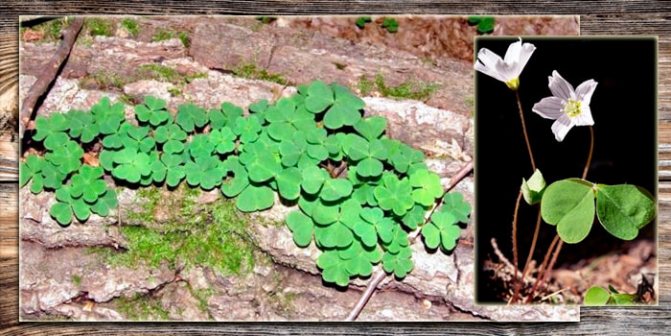

The presence of oxalic and other acids with prolonged use or violation of dosages carries the risk of developing pathologies of the kidneys and urinary tract. The herb will also have a negative effect on the body with a tendency to joint diseases. Consultation of a therapist is required before use.


